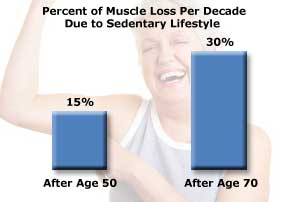
Creating Your Fitness at 40 and Fitness at 50 Plan
It’s obvious to anyone over 40 and 50, staying fit isn’t as easy as it used to be. At middle age, it seems that our bodies have priorities other than building bigger muscles and looking like a 20-year old. And, let’s not talk about (but we will) the demands of our day-to-day lives that leave little time for anything like exercise.
Regardless of age, fitness is always important to our health. However, it’s extremely important to maintain a fitness program during middle age. A healthy active routine can help prevent or substantially slow down a number of health concerns that seemingly crop up suddenly as we enter middle age, including:
- Heart disease
- Bad cholesterol levels
- Stroke
- Hypertension
- Colon and breast cancer
- Muscle and joint aches
- Type 2 diabetes
- Depression
- Bone loss through menopause
It can also help slow down the aging process and the decrease of strength and energy. Not to mention the tendency for weight gain as our metabolism slows down, our ability to store fat speeds up and our exasperation increases as pants keep getting harder to zip up.
Taking Charge of Your Fitness Now Means a Quality Life Today and Tomorrow

At Healthy Midlife, we view a well-rounded fitness plan as the key to a quality, energetic and fun-filled life throughout our 40s, 50s and early 60s.
It’s also an investment for a more independent life well into our senior years. A life where we have the physical ability to easily travel, walk up stairs, lift up and hold grandchildren, and pursue hobbies and interests without the limitations of chronic illnesses brought on by a sedentary lifestyle. That type of freedom is more than worth 30 minutes of activity a day.
Just How Much Physical Activity Do We Need to Get Fit?
Surprisingly, not a lot. According to the 2008 Physical Activity Guidelines for Americans, published by the U.S. Department of Health and Human Services, adults can gain substantial health benefits with just:
- 2.5 hours (150 minutes) moderate aerobic activity per week. That’s just 21 minutes each day of the week or 50 minutes of activity 3 days a week.
- Or, just 1.25 hours (75 minutes) of vigorous aerobic activity per week. That’s just 10 minutes each day of the week or just 25 minutes 3 days a week.
Physical activity should be at least 10 minutes at a time.
How to Know if You’re Exercising Moderately
You’ll know if you’re performing a moderate aerobic activity if it’s lightly challenging. You breath fast, but are not completely out of breath. After 10 minutes, you start to sweat a little. If you’re with a partner, you can still conduct a conversation, but not intensely.
Examples of Moderate Aerobic Activities:
- Brisk walking at 3 mph or faster
- Bicycling slower than 10 mph
- Tennis doubles
- Dancing
- General gardening
How to Know if You’re Exercising Vigorously
If you’re being challenged physically, you can consider the activity vigorous. You’ll find yourself breathing deeply and rapidly. You started to sweat just a few minutes into your routine. You can’t say a few words without stopping to take in a breath.
Examples of Vigorous Aerobic Activties:
- Jogging, running or racewalking
- Swimming laps
- Tennis singles
- Biking faster than 10 mph
- Jumping rope
- Heavy gardening like major digging or hoeing
- Hiking uphill
Don’t Neglect Your Muscles During the Week
Losing muscle mass and strength can begin after 30, speed up after 40 and really pick up speed after 50. While this is a natural process with aging, we can slow the process down. Throughout life, we’ve heard the phrase “use it or lose it,” and that definitely comes into play with our muscles, regardless of age. If we don’t stress our muscles on a regular basis, our strength will decline and our muscle tissue will disappear.
A good fitness plan, especially one designed for fitness over 40 year olds, should include a solid muscle strengthening component.
You should dedicate at 2 days a week to muscle strengthening activities that target all of the major muscle groups:
- Legs
- Hips
- Back
- Chest
- Stomach
- Shoulders
- Arms
Each muscle group should be repeatedly stressed 8 to 12 times per workout session.

Don’t let Midlife Challenges Stop You From Getting Fit
Sticking to a routine exercise plan can be challenging. Fitness over 40 seems to take less priority than other things in your life, like raising teens, job hassles, older parents, etc. And, fitness over 50 can be challenging as your life starts to change substantially, such as kids leaving home, hormonal changes, job stresses, etc.
Overcoming most challenges in life can start by simply knowing “why” it’s important to do so. Climbing the stairs without breathing hard is a why. Being able to lift groceries today and later in life is a why. Not being frail and having more control in our lives during our golden years is a why. Reducing the risk of heart disease is a why. Getting off of the cholesterol and high blood pressure pills is a why.
Make time for fitness during your middle age a priority. Ask your friends, spouse and children to hold you accountable. Get a fitness partner. Whatever it takes, there’s no better time to start getting fit than today.













